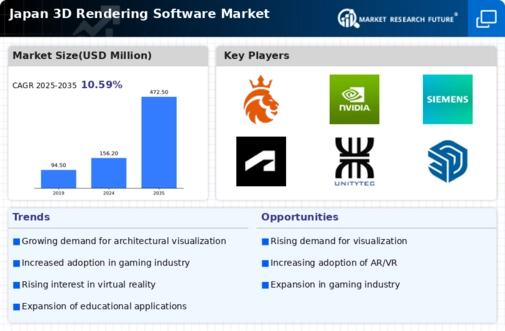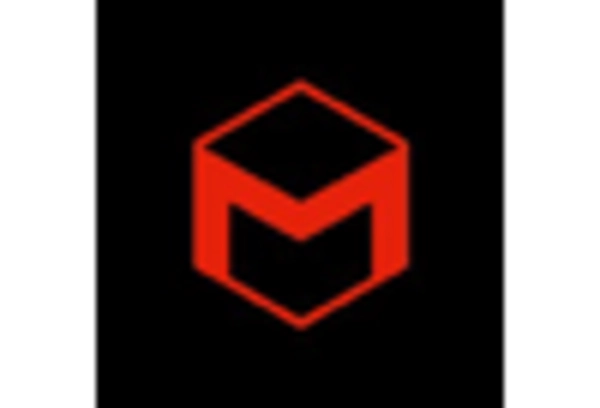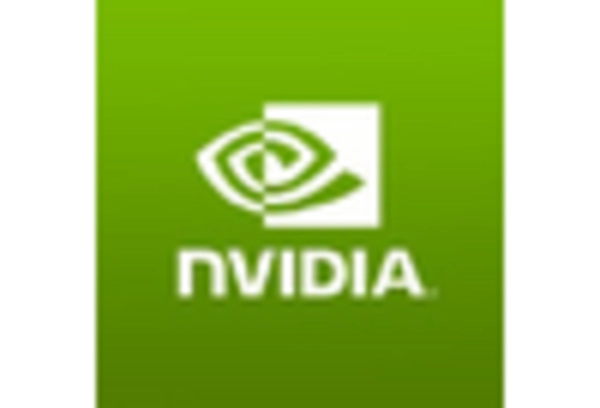Technological Advancements in Hardware
The rapid evolution of hardware technology in Japan is a critical driver for the 3d rendering-software market. With the introduction of more powerful GPUs and CPUs, rendering processes have become faster and more efficient, allowing for real-time rendering capabilities. This advancement is particularly relevant in industries such as architecture and product design, where quick iterations and high-quality visualizations are essential. In 2025, the market for graphics processing units in Japan is anticipated to grow by approximately 15%, reflecting the increasing demand for enhanced rendering capabilities. As hardware continues to improve, software developers are likely to innovate further, creating more sophisticated tools that leverage these advancements, thereby expanding the overall market.
Rising Demand in Entertainment and Media
The entertainment and media sectors in Japan are experiencing a notable surge in demand for high-quality visual content, which significantly influences the 3d rendering-software market. As the popularity of animated films, video games, and virtual reality experiences continues to grow, the need for sophisticated rendering solutions becomes increasingly apparent. In 2025, the Japanese video game market alone is projected to reach approximately $20 billion, indicating a robust appetite for advanced graphics. This trend suggests that companies are likely to invest heavily in 3d rendering software to enhance visual storytelling and user engagement. Furthermore, the integration of 3d rendering in live events and streaming services is expected to further propel market growth, as creators seek to deliver immersive experiences that captivate audiences.
Expansion of Virtual and Augmented Reality
The growing interest in virtual reality (VR) and augmented reality (AR) applications in Japan is significantly impacting the 3d rendering-software market. Industries such as gaming, education, and training are increasingly adopting VR and AR technologies to create immersive experiences. In 2025, the AR and VR market in Japan is projected to reach around $10 billion, highlighting the potential for growth in this area. As companies seek to develop engaging content for these platforms, the demand for high-quality 3d rendering software is likely to rise. This trend indicates that software providers may focus on developing tools specifically tailored for VR and AR applications, thus driving innovation and competition within the market.
Growing E-commerce and Product Visualization Needs
The e-commerce sector in Japan is rapidly evolving, leading to an increased demand for high-quality product visualization. As online shopping continues to gain traction, retailers are recognizing the importance of providing customers with realistic 3d representations of products. This trend is particularly relevant in industries such as fashion, furniture, and electronics, where visual appeal plays a crucial role in purchasing decisions. In 2025, the e-commerce market in Japan is projected to reach approximately $100 billion, indicating a substantial opportunity for the 3d rendering-software market. As businesses strive to enhance the online shopping experience, the demand for advanced rendering solutions that can create lifelike product images is likely to grow, driving further market expansion.
Increased Investment in Architectural Visualization
The architectural sector in Japan is witnessing a significant shift towards the use of 3d rendering software for visualization purposes. As architects and designers strive to present their concepts more effectively, the demand for realistic and interactive visualizations is on the rise. In 2025, the architectural visualization market is expected to grow by approximately 12%, driven by the need for enhanced client presentations and marketing materials. This trend suggests that architectural firms are likely to invest in advanced rendering solutions to improve their competitive edge. Consequently, the 3d rendering-software market is poised to benefit from this increased investment, as firms seek tools that can deliver high-quality visual outputs and streamline the design process.

















Leave a Comment